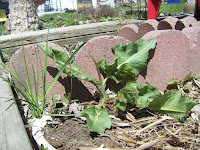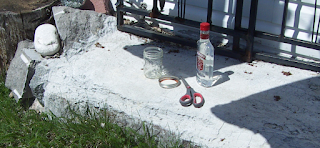I was just telling someone about how so many of the Medicine Plants that grow in my garden do so without any input from me, the supposed gardener. In many if not most cases I just stand back and let them do their thing. Whether birds bring in the seeds or they've lain dormant in the soil just waiting for permission and the right conditions, who knows - but the ones that just come up of their own accord are some of my favourites.
These wild-ish volunteers have so much more personality than anything I could plant. I find they have more medicine, too.
 |
| click to embiggen! |
Here's what some of my volunteers look like right now, the beginning of May. After a cold spring we're a little behind, but hey, we're getting there!
Check out all the rosettes of mullein that volunteered in this one small area (shown right). I planted echinacea angustofolia - a more medicinal member of the family than the usual purpurea - in there last year and I was worried about their survival. I needn't have been, the mullein kept the echinacea warm and protected all winter (thanks mullein!). As biennials, this summer the mullein will send up their 'torches', (flower spikes, which can be 6ft tall), take up way more room than they ought to, attract hummingbirds and be just delightful. I love mullein, it's pretty, it's good medicine and, as it happens, a good companion plant.
Here's a closer shot of one of the mullein rosettes. It's about the size of a dinner plate .. no, make that a platter. It's pretty big.
Note the texture (fuzzy) and somewhat rounded leaves.
Now, I've known some folks to confuse mullein and comfrey, so here for comparison is a shot of (one of) my (many, many) comfrey colonies, a few days out of the ground.
Yes, the leaves are gathered in a sort of rosette, but not as pronounced as mullein is. They're also pointed and not fuzzy - in fact they're quite rough.
Mullein only lives for 2 years (biennial), whereas comfrey comes back year after year (herbaceous perennial). The roots and leaves of both are useful. If I wanted to use these plants, I'd take them now, before the energy goes into producing flowers. I eat comfrey leaves, cooked, in small amounts (over-consumption can be hard on the liver) but - for the record - mullein leaves are not edible.
Please don't use either of these plants for toilet paper, despite what you may have read elsewhere.
 This is yellow dock, sometimes known as curly dock (rumex crispus if you want to google it). It's an ungainly looking plant, not terribly attractive in any stage of its life. But it's yummy wild food - for those who like their greens with zing and texture, that is. While young (right now) the leaves have a sour, almost lemony flavour and they're quite tender. As they mature they become fibrous and bitter as hell. I nibble the young ones while I'm out in the garden, the older ones I steep for 6 weeks in apple cider vinegar for a zippy salad dressing.
This is yellow dock, sometimes known as curly dock (rumex crispus if you want to google it). It's an ungainly looking plant, not terribly attractive in any stage of its life. But it's yummy wild food - for those who like their greens with zing and texture, that is. While young (right now) the leaves have a sour, almost lemony flavour and they're quite tender. As they mature they become fibrous and bitter as hell. I nibble the young ones while I'm out in the garden, the older ones I steep for 6 weeks in apple cider vinegar for a zippy salad dressing.Here are a few more:


Young cleavers, coming up near a sunwarmed rock.
Baby nettles. Paul used reclaimed wood from our old deck to make the garden beds. Stinging nettles just love being near decaying wood. These ones are on the inside of the bed, at least. In a couple of days there will be sprouts on the outside, too.
 |
| Well, hello there! |
Call me crazy, but this is my pride and joy, a baby burdock. Technically not a volunteer, but a nice surprise. Last fall, for some reason I don't understand, I couldn't find any damn burdock in the wild. Well okay I found one, but when I tried to dig it up, it broke off (typical). Not even big enough to give me a thimbleful of tincture, I tucked it into the soil of one of my beds, wished it luck and walked away. Lo and behold, it grew! I'll be digging it up in a couple of months, before it flowers - it's another biennial.
 |
| Tools of the trade, lol. |
Thanks to the weeds, er, wild volunteers, tincture season has officially begun, yay!! At the foot of the cement 'bench' above, nestled in the grass, we have yarrow. Just about anyone who has an imperfect lawn has yarrow nestled in the grass, come to think of it ..
 |
| Does this look familiar? |
Yarrow is another "herbaceous perennial", meaning if we let this grow (and we will), it will send up flower stalks later in the summer. The flower is the part normally used for tincture making or drying for teas, but the young tender feathery leaves have their uses as well. I'll be tincturing this batch, but you can also nibble them or some folks chop them up and add them to salads. Right now they have a mildly peppery and rather aromatic taste/fragrance.
Take the equipment to the plant, if you can. That's impractical out in the wild, but it works fine when I'm steps from the house. Here you'll see I've loosely filled the jar with whole leaves.
Next, I stuck my scissors into the jar and snipped the leaves into somewhat smaller pieces. Not too small. As you can see, what looked like a goodly amount of herb has now shrunk to a dishearteningly small amount! That's okay.
Add vodka - the leaves start to float and puff up again. In this case, I didn't completely fill the jar; I'll be adding more herb to it in a few days so I left some room. Yarrow is a 'cut and come again' plant, harvesting it will actually stimulate new growth.
That's something you rarely read about when it comes to tincture making - you don't have to make a batch all at once! Can you believe it took me years to figure that out?
See? The herbs are puffing up even more, a few minutes later. The jar will sit somewhere (out of direct sunlight) near by, so I remember to shake it a couple of times a day. It will be ready to strain and use in about 6 weeks.
It's just so damn easy to make tinctures I don't know why anyone wouldn't rather do it for themselves than order them. If you've got access to the plants, trust me, you can do this.
Now, if you are the lucky owner of an imperfect lawn and/or somewhat weedy flower or vegetable beds, go have a look with different eyes at what's coming up out there. You never know, it might be food. Or medicine. You might actually have your own half-wild apothecary.








You really do have quite the selection! Time I walk the yard and take stock in what all is out there! My comfrey is still all flower stalks! The bees needed them!
ReplyDeleteThis looks super easy to make. Never thiutho about it. Is the process the same with dry leaves or roots?
ReplyDeleteTeddy
Yep, Teddy, the process of tincture making is pretty much the same no matter what you're using.
DeleteThat said - Powdered or finely ground dried material don't work generally as well; they tend to soak up the vodka. You're better off if the leaves are whole (or nearly so) and the roots are in chunks. If you're using dried plant material, when it comes time to strain your tincture out you'll have to really squeeze out those herbs to get every drop.
Then there's the possibility of making decocted tinctures, they're great when you're working with dried roots or bark, not so much with leafy material.
Do I not have a how-to post for making tinctures? I'll have to do something about that.
I think you wrote about tincture making before.
ReplyDeleteI was reading the "other" ingredients on a lemon balm extract and it said: alcohol and vegetable glycerin. What is the glycerin for? I am itching to make something but the back of my woods have mostly thorny plants. Some of them are blackberries, but the rest are just scary looking.
Teddy
I'm not sure what the reason for using both glycerine and alcohol would be. Glycerine is sometimes used on its own to make tinctures for children or others who don't want to ingest alcohol. I haven't looked into this much because I don't like the taste/texture and it's far more expensive than vodka. My best guess is that it's in there because it's sweet tasting, not because it's a better at extracting the medicine out of the plant. I could be wrong though. It's one of those 'great debates' in herbalism, some say it extracts flavours better. I disagree, I think glycerine's sweetness flattens them out.
DeleteHmmm, I wonder what those thorny things in your woods are? What's scarier than blackberry? Barberry perhaps? Prickly ash? Hawthorn? Now I'm intrigued. You could send me pics by email and we could see if we can figure it out.
For those who are wondering, the plant in question turned out to be a thistle. Yep, thems some scary looking prickles.
DeleteI will be happy if they turn out to be something useful because there are maaany of them. Later.
ReplyDeleteTeddy